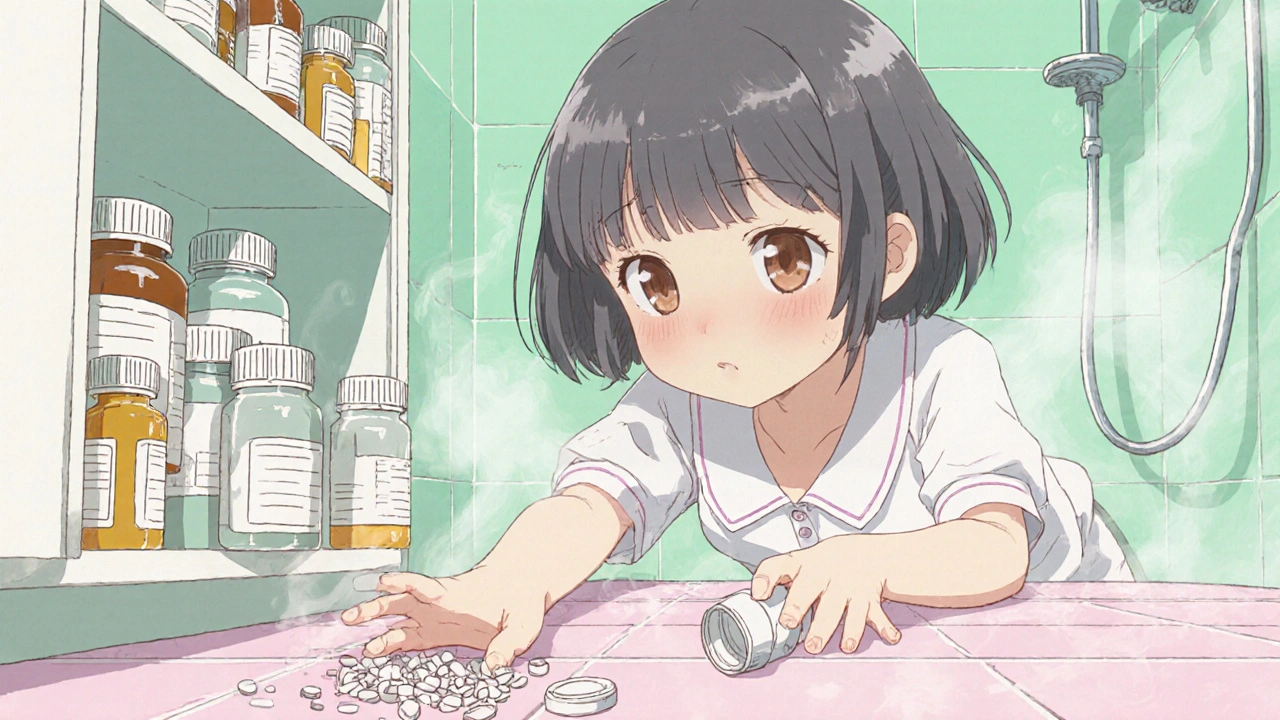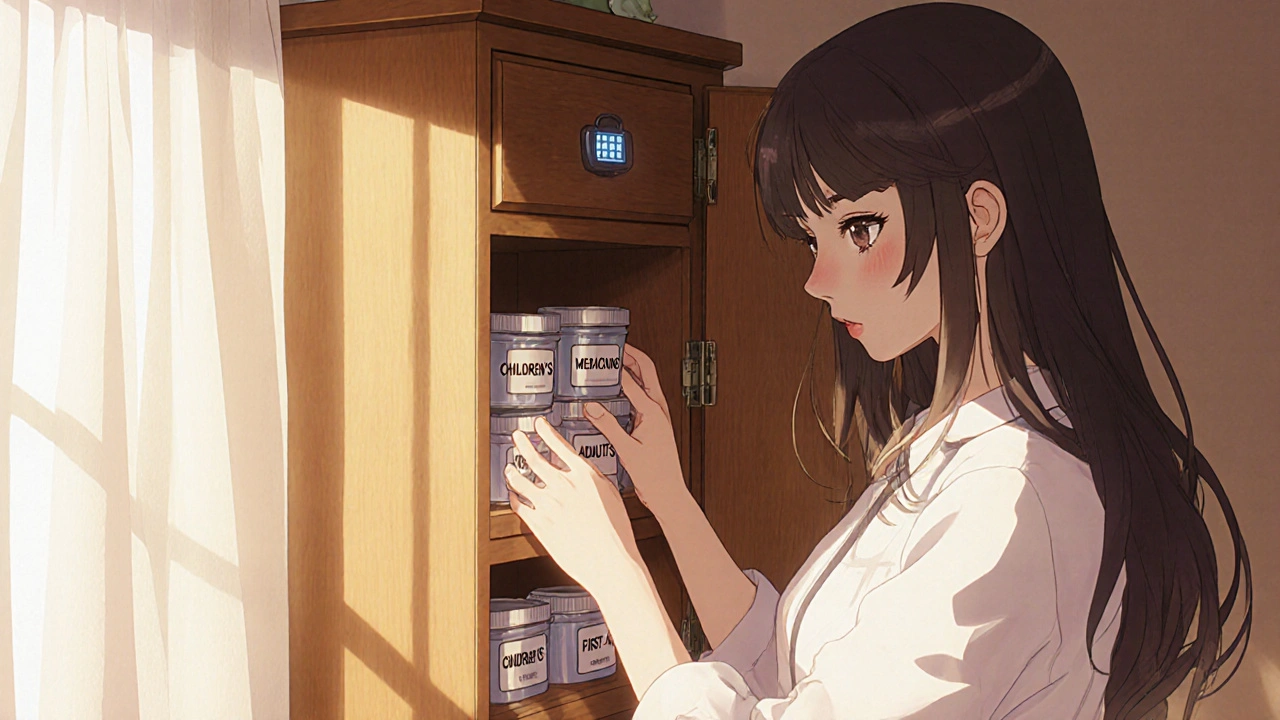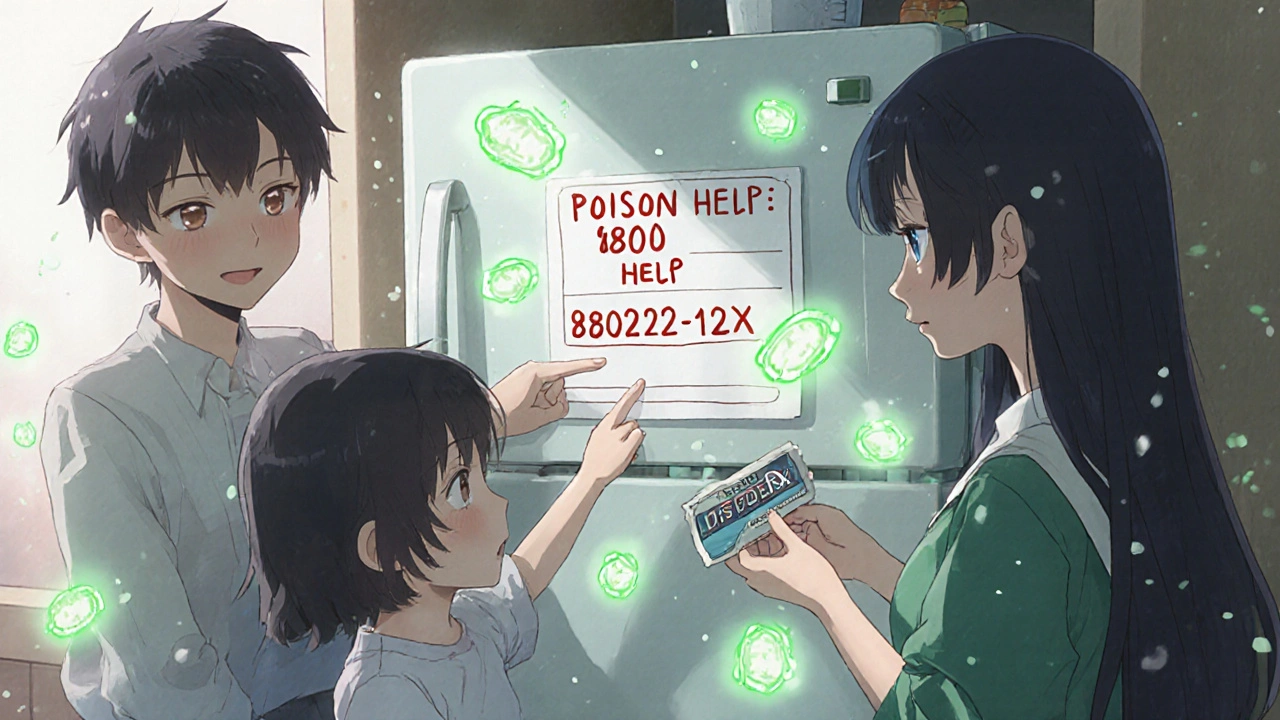How to Build a Safe Home OTC Medicine Cabinet for Families
 Nov, 17 2025
Nov, 17 2025
Most families keep medicines in the bathroom cabinet-right next to the shower. It’s convenient. But it’s also dangerous. Moisture from steam can make pills crumble, weaken their power, or even turn them toxic. And if your kids can reach the sink, they can reach the medicine. Every year, over 60,000 children under five end up in emergency rooms after swallowing medications they shouldn’t have. That’s not a statistic-it’s a real risk in homes that think they’re being careful.
Stop the Bathroom Cabinet Myth
The bathroom is the worst place for medicines. Heat, humidity, and light all break down drugs faster than you think. The U.S. Pharmacopeia says most medications start losing effectiveness above 86°F (30°C). Your shower turns the air into a sauna. That’s not just bad for your skin-it’s bad for your Tylenol, your allergy pills, your children’s vitamins. Move everything out. Don’t just relocate. Rebuild. Find a high cabinet in a dry room-like a linen closet, bedroom shelf, or even a locked drawer in your dresser. The goal isn’t convenience. It’s safety. The American Academy of Pediatrics recommends storing medicines at least four feet off the ground. That’s not a suggestion. It’s a minimum barrier.What Belongs in the Cabinet
Not everything that’s been sitting around should stay. Start with a full clean-out. Empty the cabinet. Lay everything out on the table. Sort into three piles: Keep, Discard, and Questionable. Keep: Only active, unexpired OTC meds you actually use. That means:- Acetaminophen (Tylenol) and ibuprofen (Advil, Motrin) for fever and pain
- Antihistamines like cetirizine (Zyrtec) or loratadine (Claritin) for allergies
- Hydrocortisone cream for rashes
- Antacids like famotidine or calcium carbonate
- First-aid staples: bandages, gauze, alcohol wipes, tweezers
- Thermometer (digital, not glass)
- Saline nasal spray and drops
Lock It Down-Not Just the Cap
Child-safety caps? They’re not child-proof. A 2021 Johns Hopkins study found that 42% of kids aged 4 to 5 can open standard child-resistant bottles in under 10 minutes. That’s not a failure of the cap. It’s a failure of assumption. If your cabinet doesn’t have a lock, install one. Simple plastic childproof locks from hardware stores work fine. Or use a small combination safe. Even a locked drawer inside a cabinet adds a layer of protection. The goal isn’t to make it impossible to access-it’s to make it hard enough that a child won’t get through before you notice. And don’t forget teens. The Hanley Foundation reports that 54% of teens who misuse prescription drugs get them from home cabinets. If you have opioids, benzodiazepines, or ADHD meds in the house-even if they’re prescribed-those need double security: locked inside a locked cabinet. No exceptions.
Organize for Clarity, Not Just Space
A cluttered cabinet is a dangerous cabinet. Group items by use:- Children’s meds (in separate, labeled containers)
- Adults’ daily meds
- First-aid supplies
- Seasonal items (like allergy meds in spring, cough syrup in winter)
Dispose of What You Don’t Need-Safely
Never flush pills down the toilet. Never throw them in the trash without mixing them with something unappetizing-like coffee grounds or cat litter. But even that’s not enough. The best way? Use a drug take-back program. CVS, Walgreens, and many local pharmacies now have free disposal kiosks. In 2023, the DEA’s National Prescription Drug Take Back Day collected over a million pounds of unused meds. That’s the standard. Find your nearest drop-off location through the DEA website or ask your pharmacist. If you can’t get to a kiosk, use DisposeRX powder. It’s a free, FDA-approved powder you add to pills or liquids in the bottle. It turns them into a gel that can’t be reused or misused. Many pharmacies give it out free with opioid prescriptions. Ask for it.Keep a Medication List-And Share It
Write down every medication in your cabinet-prescription and OTC. Include:- Name
- Dose
- Why you take it
- Expiration date

Check It Every Six Months
Set a reminder. Every January 1 and July 1, do a full cabinet review. Ask yourself:- Is anything expired?
- Are the bottles still sealed?
- Are the labels readable?
- Is the lock still working?
- Did someone new come into the house? (Grandma? Babysitter? Teen friend?)
Emergency Plan: Know the Number
No matter how safe you make your cabinet, accidents happen. That’s why every phone in the house must have Poison Help: 800-222-1222 saved as a contact. Post it on the fridge. Write it on the inside of the cabinet door. Tell every caregiver-babysitters, grandparents, teachers. Poison control centers are free, confidential, and staffed by nurses and pharmacists who know exactly what to do. Don’t wait for symptoms. Don’t Google it. Call immediately. They’ve handled over 1 million calls a year. They’ve seen it all.It’s Not About Perfection-It’s About Progress
You don’t need a locked vault. You don’t need to throw out everything. You just need to stop treating your medicine cabinet like a junk drawer. Move it out of the bathroom. Lock it. Clean it. Label it. Check it. And teach everyone in the house that medicine isn’t candy. The CDC’s 2024 National Action Plan aims to cut pediatric medication poisonings by 15% by 2026. That won’t happen with posters or pamphlets. It happens when families take one step: locking the cabinet. Then another: checking the dates. Then another: calling poison control before panicking. Your family’s safety isn’t about having the best meds. It’s about having the right system. And that system starts with one decision: stop storing medicine where the kids can reach it.Can I keep my child’s medicine in the bathroom if it’s in a locked box?
No. Even locked boxes in the bathroom are exposed to moisture and heat, which can break down medications. The American Academy of Pediatrics and pharmacy experts agree: store all medicines in a dry, cool, out-of-reach place like a bedroom closet or linen shelf. A locked box helps, but it doesn’t fix the environment. Humidity ruins pills faster than kids can open them.
What if I have a toddler who’s already opened a medicine bottle?
Call Poison Help at 800-222-1222 immediately. Don’t wait for symptoms. Don’t try to make them vomit. Don’t give them milk or charcoal unless instructed. Poison control specialists are trained to handle these cases in real time-they’ll tell you exactly what to do based on what was taken, how much, and when. Keep this number saved in every phone and posted in plain sight.
Are vitamins safe to leave out? They’re natural, right?
No. Vitamins can be just as dangerous as pills if taken in excess. Iron supplements, in particular, are a leading cause of fatal poisoning in young children. A single adult dose of iron can kill a toddler. Store all vitamins like medicine-locked, high, and away from food. Just because it’s labeled “natural” doesn’t mean it’s safe in the wrong hands.
How often should I check expiration dates?
At least every six months. Set a reminder for January 1 and July 1. Expired pain relievers may not work. Expired antibiotics can cause harmful reactions. Even eye drops and creams lose potency. The FDA says if it’s more than a year past the expiration date, toss it. Don’t risk it. Your cabinet isn’t a museum-it’s a tool. And tools need maintenance.
Can I use a smart lock or app to monitor the cabinet?
Yes-and it’s becoming more common. Smart asset protection devices now send alerts to your phone when the cabinet is opened. These are especially helpful if you have teens, visiting relatives, or caregivers who aren’t always present. Adoption has tripled since 2020. They cost under $50 and integrate with most home security systems. They don’t replace locks-they add a layer of awareness.
What should I do if I find old, unlabeled pills in the cabinet?
Toss them. If you can’t read the label, don’t guess. If you don’t know what it is, don’t keep it. Unlabeled pills are a risk to everyone-children, guests, even you. Take them to a pharmacy with a disposal kiosk. Most CVS and Walgreens locations offer free disposal. If you can’t get there, mix them with coffee grounds or cat litter, seal them in a plastic bag, and throw them in the trash. Never flush them.
Is it okay to store OTC and prescription meds together?
Yes-but only if they’re clearly labeled and separated. Keep prescriptions in their original bottles with the pharmacy label intact. Store OTC meds in labeled containers. Mixing them without labels increases the risk of accidental overdose or interaction. If you use a pill organizer, make sure it’s locked and only used for daily doses-not long-term storage.
Do I need to lock up cough syrup and allergy drops?
Absolutely. Liquid medications are especially dangerous because they look like juice. A child can drink a whole bottle in seconds. Cough syrups often contain dextromethorphan, which can cause hallucinations and seizures in high doses. Even eye drops can be toxic if swallowed. Treat every liquid medication like a controlled substance-lock it up, keep it high, and check it regularly.
What if my child visits a home without a locked cabinet?
Talk to the host before the visit. Say, “We’re being extra careful with medicines at home, and we’re wondering if you have them stored safely.” Most parents will appreciate the reminder. If you’re uncomfortable, bring a small travel lock or portable safe for your child’s meds. Better to be safe than sorry. Accidents happen in the friend’s house just as often as at home.
Can I use the same cabinet for pets’ medications?
No. Pet meds are not meant for humans, and human meds can be deadly to animals. Store pet medications separately, ideally in a different location. Never mix them. If your dog eats a human painkiller, it can be fatal. Keep pet meds in their own locked container, labeled clearly, and away from family access.

Iska Ede
November 18, 2025 AT 04:43So you're telling me my bathroom cabinet is basically a toddler's candy store with a side of chemical hazard? 😅 Guess I'm upgrading from 'meh' to 'locked drawer in the bedroom' tomorrow. Thanks for the guilt trip I didn't know I needed.
Katelyn Sykes
November 18, 2025 AT 23:02Just did my biannual cabinet purge and holy hell I found three expired cough syrups from 2020 and a bottle labeled 'mystery pills' that I swear I got from a friend at a concert. Tossed it all. Also bought those DisposeRX packets free at CVS. Life change. Kids still don't know where the meds are and I sleep better. 🙌
Gabe Solack
November 19, 2025 AT 04:03Smart locks for medicine cabinets? Yes. I got one for $45 and now I get a push notification every time the cabinet opens. My teen thinks it's 'creepy' but I told him if he wants to take my Advil he's gotta ask first. He hasn't tried to open it since. 🤝
Bailey Sheppard
November 20, 2025 AT 08:57This is one of those posts that makes you feel like a slightly better parent without making you feel like a terrible one. Thank you. I moved my meds to the top shelf of the linen closet last week. No lock yet, but the kids can't reach it. Small wins.
Gabriella Jayne Bosticco
November 20, 2025 AT 15:28I love how this doesn't just say 'lock it up' but actually gives you the how. I used to think vitamins were harmless until I read that iron can kill a toddler. Now my kids' multivitamins are locked in the same drawer as the ibuprofen. No more 'natural' = 'safe' assumptions. Good stuff.
Sarah Frey
November 20, 2025 AT 21:15As a registered nurse, I cannot stress enough the importance of proper medication storage. The misconception that 'it's just a pill' is dangerous. I've seen children hospitalized after ingesting liquid antihistamines stored on a bathroom counter. Even if you think your child 'wouldn't do that,' statistics don't lie. This guide is practical, evidence-based, and urgently needed. Thank you for sharing.
Shaun Barratt
November 21, 2025 AT 08:00The U.S. Pharmacopeia’s temperature thresholds for pharmaceutical stability are well-documented, and the degradation kinetics of acetaminophen under elevated humidity conditions are empirically verified. The bathroom environment, particularly post-shower, exceeds the recommended 25°C ceiling for most solid oral dosage forms, resulting in hydrolytic decomposition and potential formation of toxic byproducts such as p-aminophenol. A climate-controlled, dry, and inaccessible storage location is not merely advisable-it is a pharmacological imperative.
Yash Nair
November 21, 2025 AT 10:22USA is so weak. In India we just keep medicine in kitchen shelf. Kids learn fast what not to touch. Why you need lock? Why you need smart device? You just teach your child respect. You are too soft. Our grandparents didn't have locks and we turned out fine. You overthink everything. Medicine not candy? Of course not. But also not war zone.
Girish Pai
November 22, 2025 AT 19:51Per the WHO’s 2023 Medication Safety Framework (MSF v4.2), ambient humidity levels above 60% RH in non-climate-controlled environments induce polymorphic transitions in crystalline APIs, particularly in non-hygroscopic excipients like lactose monohydrate. The architectural placement of pharmaceuticals within domestic settings must adhere to ISO 11607-1:2022 compliance standards for storage integrity. Failure to implement tiered environmental controls constitutes a Level 2 medication safety breach under CDC Class 3 protocols.
Brenda Kuter
November 23, 2025 AT 05:05Did you know the government puts tracking chips in pill bottles? That’s why they want you to lock them up-they’re watching who takes what. And the ‘DisposeRX powder’? It’s a cover. They’re turning your meds into nano-surveillance gel. Don’t fall for it. I keep mine in the freezer under my socks. No one looks there. And I never flush. I bury them in the backyard. 🌱👁️
Heidi R
November 24, 2025 AT 00:00How quaint. You think a locked drawer is enough? My neighbor’s child died from a child-resistant cap. You’re all amateurs. Real safety requires biometric locks, blockchain logs, and mandatory caregiver training. If you’re not using a MedSafe Pro X2 with AI intrusion detection, you’re not just negligent-you’re culturally tone-deaf.
Hal Nicholas
November 24, 2025 AT 05:36I’ve seen this before. People think they’re being responsible by moving meds to a closet. But you’re still letting your kids see them. You’re still normalizing medicine as part of the home landscape. That’s the real problem. You don’t need to lock it-you need to erase it from their consciousness entirely. Hide it in a false wall. Make it a secret. That’s real parenting.
Kristi Joy
November 25, 2025 AT 23:43Just wanted to say thank you to the original poster. This was exactly the nudge I needed. I’ve been putting off cleaning my cabinet for months. Today I did it-tossed 17 expired bottles, labeled everything, and installed a simple lock. My 3-year-old still asks for 'the purple medicine' but now she has to ask me. That’s progress. And that’s enough.